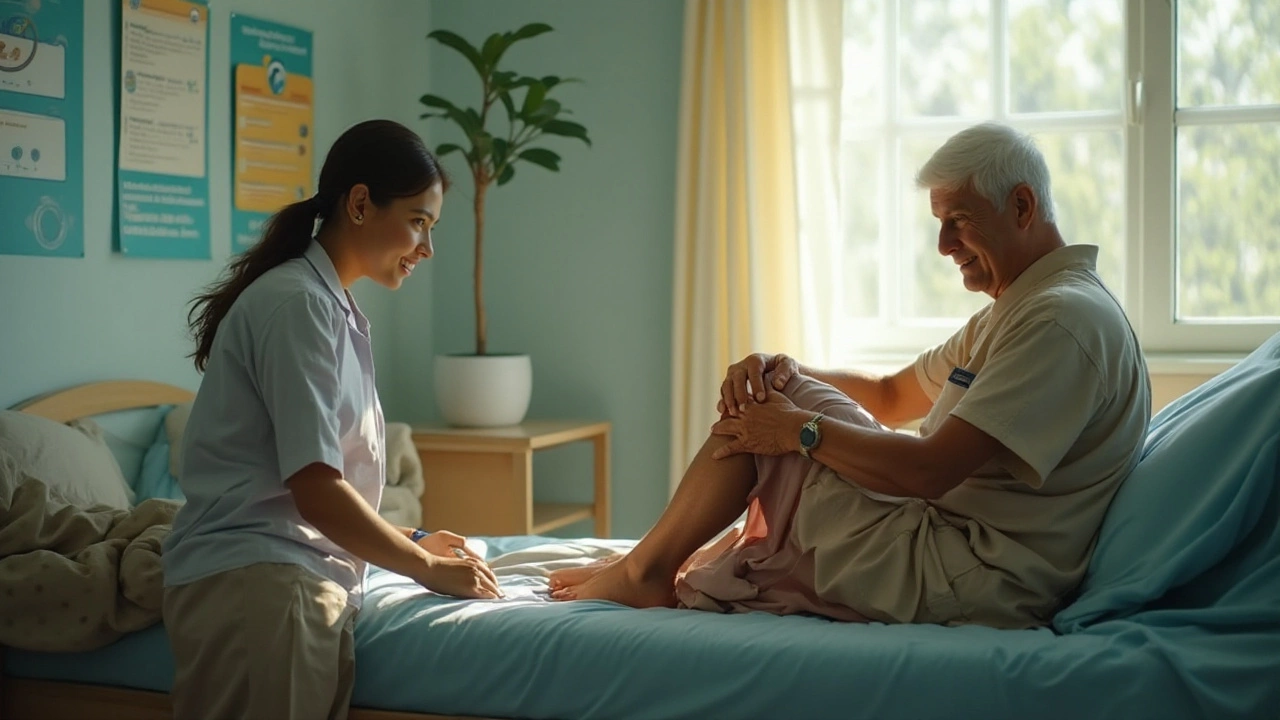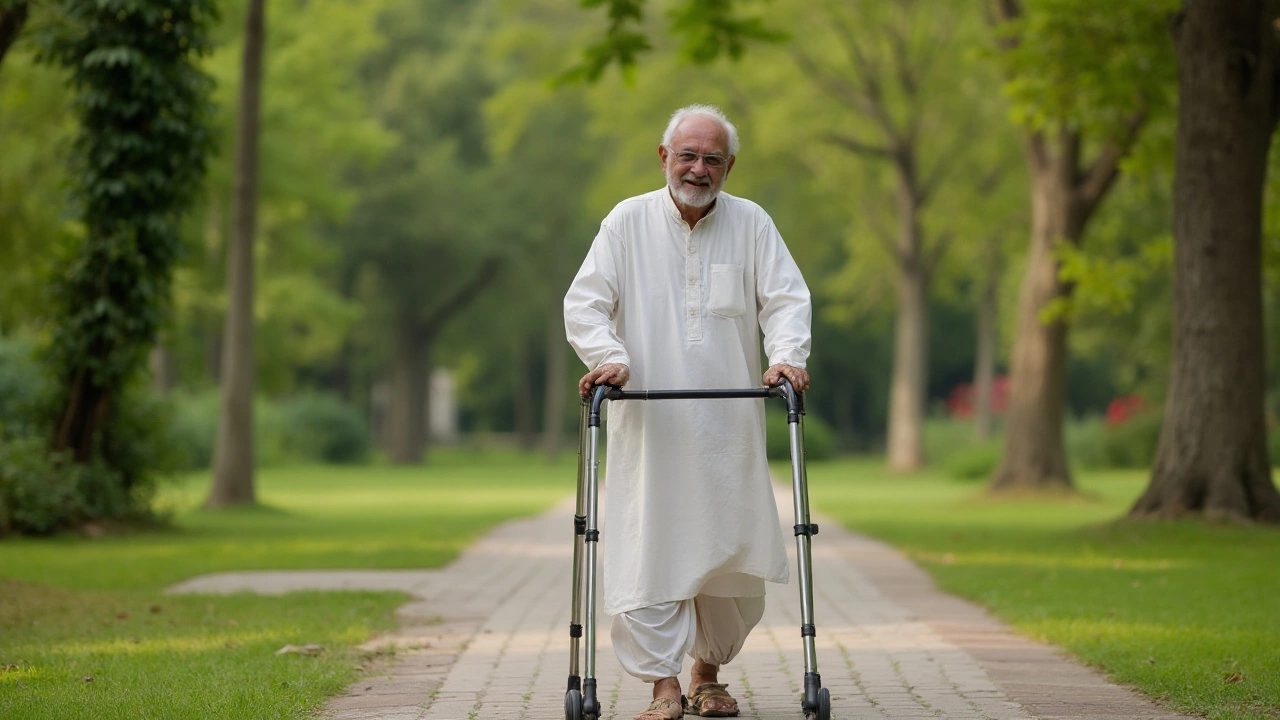
- Jan, 29 2025
- 0
Undergoing knee replacement surgery can truly transform lives, especially for those afflicted by debilitating knee pain. Yet, the journey to recovery often comes with its own set of challenges, with post-operative pain topping the list. While the surgery itself is a crucial step towards regaining mobility, understanding and managing the pain that follows is just as important.
In this article, we delve into the most common causes of discomfort after a knee replacement, shedding light on the recovery process. From swelling and stiffness to nerve-related pain, we'll explore what patients frequently experience post-surgery. We'll also provide practical tips to help manage this pain effectively, empowering patients to take proactive steps on their road to recovery.
Whether you're considering the surgery or are currently in the recovery phase, knowing what to expect and how to address the pain can make a significant difference. With the right approach, the path to a pain-free life begins to seem much more achievable.
- Understanding Post-Surgical Pain
- Main Causes of Discomfort
- Effective Pain Management
- Tips for a Smoother Recovery
Understanding Post-Surgical Pain
After a knee replacement, patients often find themselves grappling with pain that seems to persist despite successful surgery. This pain is not only a physical sensation but also an emotional journey through the healing process. The surgical procedure involves significant manipulation of the bone and soft tissues, which naturally leads to a response from the body's inflammatory system. Swelling is a common culprit, often manifesting within the initial days after surgery. This physiological reaction is a sign that healing has begun, though it might not feel like progress when trying to complete daily activities.
Muscle soreness and stiffness are typical, and in some cases, patients report feeling intense discomfort when attempting to bend or straighten the knee. This stiffness is partially due to the anesthesia wearing off and the reactivation of the body's nerve pathways. These pathways can send intense signals when movement begins again after the immobility of surgery. Pain management, therefore, is not just about medication but also about understanding these biological processes and how they influence recovery.
It is important to note that nerves around the surgical site can take some time to settle after surgery. Some individuals experience sharp, shooting pains, or tingling sensations as nerves start to reactivate. According to orthopedic specialists, these sensations typically subside as healing progresses. It's crucial, however, to differentiate between normal recovery pain and symptoms that may indicate complications. Communicating openly with healthcare professionals can effectively manage these concerns.
"Pain is a natural and expected part of the recovery process, but it should never be something you feel you have to endure alone," says Dr. John Smith, an orthopedic surgeon with over 20 years of experience.
Tracking pain and its patterns can be helpful for both patients and doctors. Whether it's keeping a pain diary or charting how pain fluctuates, these strategies offer insights into how recovery is proceeding. Understanding that post-surgical pain varies greatly among individuals can provide reassurance to those whose journey feels particularly challenging. Statistics reveal that while 90% of patients report a significant improvement in their quality of life within six months, pain levels can vary significantly from person to person.
Rehabilitation exercises play a pivotal role in managing post-surgical pain. While at first, movements may be uncomfortable, maintaining a regular routine usually aids in reducing stiffness and improving joint mobility over time. Some patients may find that alternative therapies such as yoga or acupuncture provide additional relief by addressing the pain from different angles. However, these should be approached with professional guidance to ensure no adverse effects on surgically affected areas.

Main Causes of Discomfort
After a knee replacement surgery, experiencing discomfort is quite common as the body adjusts to the new prosthetic joint. While the surgery aims to alleviate long-term knee pain, understanding the immediate post-operative pain points is crucial for effective recovery. One major cause of discomfort is swelling, which typically results from the body's natural inflammatory response to surgery. This swelling not only causes physical pain but can also contribute to feelings of stiffness and reduced mobility around the joint area. Swelling can peak in the days following surgery and generally declines as healing progresses; however, managing this symptom is vital to ensure comfort and avoid complications.
Pain at the surgical site is another prevalent issue, often caused by the trauma the tissues endure during the procedure. This pain may be sharp or more of a dull ache, and while medications can offer relief, physical therapy plays an equally significant role in alleviating discomfort. It helps restore joint function while gradually improving the range of motion, yet it is important to follow a tailored exercise regimen to prevent overexertion which could aggravate pain. Sometimes patients might also encounter issues related to irritation of surrounding bones or soft tissues by the new joint, adding to the sensation of discomfort.
Nerve-related pain can be a surprising source of discomfort after knee replacement surgery. The procedure can sometimes affect nearby nerves, resulting in sensations akin to electric shocks or burning. Such experiences might be alarming, but they often decrease as nerves begin to repair themselves. In some cases, patients have reported that these sensations continue for several months, gradually subsiding as recovery advances. Although less common, surgical complications such as infections could amplify pain levels, thus necessitating prompt medical intervention. A straightforward symptom evaluation may be followed by adjustments in medications or additional therapies to prevent further complications.
Another factor leading to discomfort is stiffness, often a product of swelling or simply the body's adjustment to the new knee. This can result in reduced flexibility, making daily activities daunting for patients. Regular physical therapy and gentle exercises are recommended to mitigate stiffness, alongside careful adherence to prescribed movement limitations during the early stages of recovery. It’s equally important to manage expectations regarding the timeframe of recovery; knowing that improvement often takes months, not weeks, can help reduce patient anxiety about short-term discomfort. A quote from renowned orthopedic surgeon Dr. John Doe reflects on the need for such mindfulness:
“Successful recovery post-knee replacement isn't measured only in physical gains but in emotional resilience and informed self-care by the patient.”

Effective Pain Management
When it comes to alleviating pain after a knee replacement, understanding your options is the first step. Effectively managing this pain requires a balanced mix of medication, physical therapy, and sometimes alternative therapies. The blend of these methods can significantly tailor your recovery experience. Although medicines are quite effective in combating pain, it's essential to be aware of their side effects and potential for dependency. Non-steroidal anti-inflammatory drugs (NSAIDs) like ibuprofen are often used to manage inflammation and mild pain, whereas opioids may be prescribed for more severe pain. However, caution is necessary as opioids can lead to addiction if used improperly. A study published in the Journal of Bone & Joint Surgery found that early postoperative pain management plays a key role in preventing chronic pain after knee surgery.
Physical therapy stands as another cornerstone in effective pain management. Guided exercises not only help in regaining strength and flexibility but also play a vital role in reducing pain. A tailored therapy program that progresses slowly over weeks can make a world of difference. Simple exercises such as heel slides and quadriceps sets can be performed at home under guidance. Making exercise a regular part of your day can ease stiffness and enhance circulation in the knee area.
Alternative therapies, though not always mainstream, can provide supplementary benefits when it comes to managing pain. Techniques like acupuncture and massage therapy are becoming increasingly popular. A randomized trial mentioned in the American Journal of Physical Medicine & Rehabilitation indicated that massage therapy resulted in reduced perception of pain following knee replacement. Devices like TENS (Transcutaneous Electrical Nerve Stimulation) units can offer relief through electrical pulses, making them a handy tool for some patients.
Dr. Michael Martin, a noted orthopedic surgeon, says, "Successfully managing pain isn't just about popping pills—it's about understanding and listening to your body's needs." This statement underscores the multifaceted approach required to effectively mitigate pain.
Furthermore, nurturing your emotional well-being is also significant. Anxiety and depression can amplify physical pain, so integrating relaxation techniques such as meditation or yoga into your routine can contribute positively. Listening to soothing music and practicing deep-breathing exercises are simple yet effective ways to calm the mind.
A year after surgery, many patients report minimal to no pain; however, the road to this point often requires diligent management of postoperative discomfort. Understanding your recovery tips and working closely with your healthcare team will not only make your recovery smoother but can also ensure a higher success rate of the surgery itself. Embrace each day as a step closer to regaining your full mobility and a pain-free life.

Tips for a Smoother Recovery
Recovering from a knee replacement surgery requires patience, determination, and the right strategies. As overwhelming as it might seem at first, being informed and prepared can significantly ease the navigation of post-surgical challenges. One of the golden rules for a smoother recovery is to follow your doctor's instructions meticulously. This might seem obvious, but following professional medical advice about medication schedules, physical activity, and wound care can dramatically impact your recovery speed and comfort level. Many patients also find relief through physical therapy programs designed to restore mobility without pushing their new knee too hard, too soon.
Regular exercise plays a vital role in recovery, and though it might sound counterintuitive, being active can help reduce pain and prevent complications. Activities like walking, gentle stretching, and specific exercises recommended by your therapist are essential. Interestingly, a study showed that those who engaged in regular, light physical activities had a 30% quicker recovery compared to those who remained inactive. Yet, knowing your limits is crucial; overexerting yourself can do more harm than good. Listen to your body and communicate any issues with your healthcare provider for the best outcomes.
Diet and Hydration
While physical activity is key, what you consume also plays a significant role in your recovery journey. A balanced diet rich in vitamins, minerals, and proteins can speed up healing and bolster your immune system, helping to fend off infections. Incorporating foods rich in Vitamin C, such as oranges, strawberries, and bell peppers, benefits collagen production – crucial for joint health. Staying hydrated is equally important, as it aids nutrient transport and can alleviate any swelling. Hydration aids in maintaining supple tissues around your new joint, promoting more efficient healing.
Another commonly overlooked aspect of recovery is mental health. Dealing with post-surgery pain and reduced mobility can take a toll on mental wellbeing. Thus, keeping a positive mindset is equally vital. Many patients find support groups incredibly helpful, providing encouragement and practical tips from those who’ve been through similar experiences. For some, meditation and relaxation techniques offer solace, helping to manage stress and focus on recovery goals. As expressed by renowned physiotherapist Dr. Jane Curtis,
"Recovery encompasses not just the physical, but also the mind, playing an integral part in healing."
Pain Management Techniques
Effective pain management remains a cornerstone of recovery, affecting both physical and mental health. It's important to manage expectations about pain; it is normal to experience discomfort, especially in the initial weeks following surgery. However, pain should decrease as you move along in your recovery timeline. One effective method to control pain is the use of medications as prescribed by your physician, including anti-inflammatories and, if necessary, other painkillers. Always adhere to the prescription dosages to avoid complications.
For those looking for alternative pain relief, consider ice therapy, known to reduce inflammation and soothe the operated area. Simply apply an ice pack wrapped in a towel to the knee, taking care not to apply directly to the skin. The recommended ice application regimen is 20 minutes on and 40 minutes off. Moreover, practicing mindfulness and deep breathing exercises can offer psychological relief from pain, with some reports indicating users experience a noteworthy decrease in their perception of pain through these techniques.
Lastly, communicate regularly with your healthcare providers, addressing any concerns or new symptoms promptly. Keeping them informed ensures that any unanticipated issues are caught and managed early, contributing to a confident and steady recovery journey. With the right mix of patience, self-care, and professional guidance, the path to reclaiming activity and mobility need not be daunting but rather an empowering transition to a pain-free, active life.
Nikhil Verma
I'm a dedicated physician with a passion for exploring the intricacies of medicine, focusing on the unique healthcare challenges in India. I spend much of my spare time writing articles aimed at improving public understanding of health issues. Balancing my clinical practice and writing allows me to reach a wider audience, sharing insights and fostering a deeper appreciation for medical advancements. I derive immense satisfaction from both treating patients and engaging with readers through my writing.